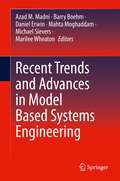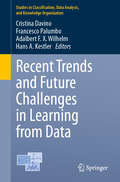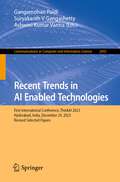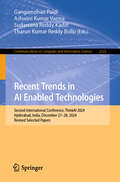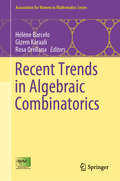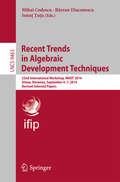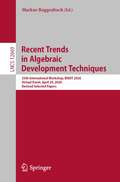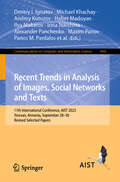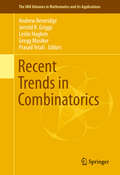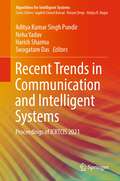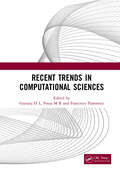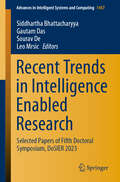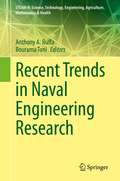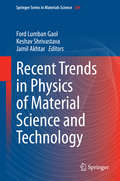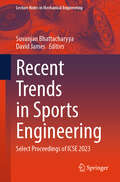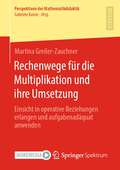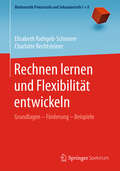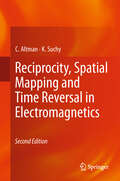- Table View
- List View
Recent Trends and Advances in Artificial Intelligence: Selected Papers from ICAETA-2024 (Lecture Notes in Networks and Systems #1138)
by Akhtar Jamil Alaa Ali Hameed Alessandro Ortis Isaac Segovia Ramirez Fausto P. GarciaThis book presents a curated selection of papers from the International Conference on Advanced Engineering, Technology, and Applications (ICAETA24), hosted by the University of Catania, Italy, in March 2024. The conference is co-organized by Istinye University, Turkey. The book delves into the forefront of technological advancements, spotlighting the latest trends and applications of artificial intelligence across diverse domains and addressing real-world challenges with transformative solutions. Readers will gain insights into state-of-the-art models and methodologies, particularly focusing on their applications on benchmark datasets. The discussions and presentations within this volume are organized around four pivotal tracks: Artificial Intelligence and Machine Learning, Big Data and Cloud Computing, Internet of Things and Sensor Technology, and Applications of Artificial Intelligence. Each track offers a deep dive into its respective domain, exploring the profound impact of technological innovations on various industries and sectors.
Recent Trends and Advances in Model Based Systems Engineering
by Azad M. Madni Barry Boehm Daniel Erwin Mahta Moghaddam Michael Sievers Marilee WheatonThis volume comprises papers from the 18th Conference on Systems Engineering Research (CSER). The theme of this volume, “Recent Trends and Advances in Model-Based Systems Engineering,” reflects the fact that systems engineering is undergoing a transformation motivated by mission and system complexity and enabled by technological advances such as model-based systems engineering, digital engineering, and the convergence of systems engineering with other disciplines. This conference is focused on exploring recent trends and advances in model-based systems engineering (MBSE) and the synergy of MBSE with simulation technology and digital engineering. Contributors have submitted papers on MBSE methods, modeling approaches, integration of digital engineering with MBSE, standards, modeling languages, ontologies and metamodels, and economics analysis of MBSE to respond to the challenges posed by 21st century systems. What distinguishes this volume are the latest advances in MBSE research, the convergence of MBSE with digital engineering, and recent advances in applied research in MBSE, including growing convergence with systems science and decision science. This volume is appropriate as a reference text in graduate engineering courses in Model-Based Systems Engineering.
Recent Trends and Future Challenges in Learning from Data (Studies in Classification, Data Analysis, and Knowledge Organization)
by Francesco Palumbo Cristina Davino Hans A. Kestler Adalbert F. X. WilhelmThis book collects together selected peer-reviewed contributions presented at the European Conference on Data Analysis, ECDA 2022, held in Naples, Italy, September 14-16, 2022. Highlighting the role of statistics in discovering novel and interesting patterns in the era of big data, it follows the motto of the conference: “Avoiding drowning in the data: recent trends and future challenges in learning from data”. The central focus is on multidisciplinary approaches to data analysis, classification, and the interface between computer science, data mining and statistics. Both methodological and applied topics are covered. The former includes supervised and unsupervised techniques with particular emphasis on advances in regression and clustering analysis and constructing composite indicators. The applications are mainly in risk analysis, biology, and education. The volume is organized into four main macro themes: methodological contributions in the social sciences and education, multivariate analysis methods for big data, innovative contributions for applications inspired by biology, and strategies for analyzing complex data in finance.
Recent Trends in AI Enabled Technologies: First International Conference, ThinkAI 2023, Hyderabad, India, December 29, 2023, Revised Selected Papers (Communications in Computer and Information Science #2045)
by Gangamohan Paidi Suryakanth V Gangashetty Ashwini Kumar VarmaThis book constitutes the refereed proceedings of the First International Conference on Recent Trends in AI Enabled Technologies, ThinkAI 2023, which took place in Hyderabad, India, in December 2023. The 7 full papers presented in these proceedings were carefully reviewed and selected from 51 submissions. The conference focuses on on up to date topics and recent trends in artificial intelligence and related technologies.
Recent Trends in AI Enabled Technologies: Second International Conference, ThinkAI 2024, Hyderabad, India, December 27–28, 2024, Revised Selected Papers (Communications in Computer and Information Science #2322)
by Gangamohan Paidi Ashwini Kumar Varma Sudarsana Reddy Kadiri Tharun Kumar Reddy BolluThis book constitutes the refereed proceedings of the Second International Conference on Recent Trends in AI Enabled Technologies, ThinkAI 2024, which took place in Hyderabad, India, during December 27-28, 2024. The 18 full papers in this book were carefully reviewed and selected from 75 submissions. These papers focus on topics of AI enabled technologies, including machine learning, soft computing, and deep learning algorithms.
Recent Trends in Algebraic Combinatorics (Association for Women in Mathematics Series #16)
by Hélène Barcelo Gizem Karaali Rosa OrellanaThis edited volume features a curated selection of research in algebraic combinatorics that explores the boundaries of current knowledge in the field. Focusing on topics experiencing broad interest and rapid growth, invited contributors offer survey articles on representation theory, symmetric functions, invariant theory, and the combinatorics of Young tableaux. The volume also addresses subjects at the intersection of algebra, combinatorics, and geometry, including the study of polytopes, lattice points, hyperplane arrangements, crystal graphs, and Grassmannians. All surveys are written at an introductory level that emphasizes recent developments and open problems. An interactive tutorial on Schubert Calculus emphasizes the geometric and topological aspects of the topic and is suitable for combinatorialists as well as geometrically minded researchers seeking to gain familiarity with relevant combinatorial tools. Featured authors include prominent women in the field known for their exceptional writing of deep mathematics in an accessible manner. Each article in this volume was reviewed independently by two referees. The volume is suitable for graduate students and researchers interested in algebraic combinatorics.
Recent Trends in Algebraic Development Techniques: 22nd International Workshop (Lecture Notes in Computer Science #9463)
by Mihai Codescu Răzvan Diaconescu Ionuţ ŢuţuThis book constitutes the thoroughly refereedpost-conference proceedings of the 22nd International Workshop onAlgebraic Development Techniques, WADT 2014, held in September 2014 in Sinaia,Romania. The 8 revised papers presented were carefully reviewed and selected from 13presentations and focus together with one invited paper on foundations ofalgebraic specification, approaches to formal specification including processcalculi and models of concurrent, distributed and mobile computing,specification languages, methods, and environments, semantics of conceptualmodeling methods and techniques, model-driven development, graphtransformations, term rewriting and proof systems, integration of formalspecification techniques, formal testing and quality assurance, validation, andverification.
Recent Trends in Algebraic Development Techniques: 25th International Workshop, WADT 2020, Virtual Event, April 29, 2020, Revised Selected Papers (Lecture Notes in Computer Science #12669)
by Markus RoggenbachThis book constitutes the thoroughly refereed post-conference proceedings of the 25th International Workshop on Algebraic Development Techniques, WADT 2020, held virtually in April 2020.The 7 revised papers presented together with an invited paper were carefully reviewed and selected from 9 submissions. The contributed presentations covered a range of topics about the algebraic approach to system specification, which encompasses many aspects of the formal design of software systems. Originally born as formal method for reasoning about abstract data types, the algebraic approach now covers new specification frameworks and programming paradigms (such as object-oriented, aspect-oriented, agent-oriented, logic, and higher-order functional programming) as well as a wide range of application areas (including information systems, concurrent, distributed, and mobile systems).
Recent Trends in Algebraic Development Techniques: 26th IFIP WG 1.3 International Workshop, WADT 2022, Aveiro, Portugal, June 28–30, 2022, Revised Selected Papers (Lecture Notes in Computer Science #13710)
by Alexandre Madeira Manuel A. MartinsThis book constitutes the thoroughly refereed post-conference proceedings of the 26th International Workshop on Algebraic Development Techniques, WADT 2022, held in Aveiro, Portugal, in June 2022.The 6 revised papers presented together with 2 invited papers were carefully reviewed and selected from 25 submissions. The contributed presentations covered a range of topics about the algebraic approach to system specification, which encompasses many aspects of the formal design of software systems. Originally born as formal method for reasoning about abstract data types, the algebraic approach now covers new specification frameworks and programming paradigms (such as object-oriented, aspect-oriented, agent-oriented, logic, and higher-order functional programming) as well as a wide range of application areas (including information systems, concurrent, distributed, and mobile systems).
Recent Trends in Analysis of Images, Social Networks and Texts: 11th International Conference, AIST 2023, Yerevan, Armenia, September 28–30, Revised Selected Papers (Communications in Computer and Information Science #1905)
by Panos M. Pardalos Andrey V. Savchenko Dmitry I. Ignatov Alexander Panchenko Michael Khachay Andrey Kutuzov Elena Tutubalina Ilya Makarov Evgenii Tsymbalov Habet Madoyan Irina Nikishina Maxim Panov Sergey ZagoruykoThis book constitutes the refereed proceedings of the 11th International Conference on Recent Trends in Analysis of Images, Social Networks and Texts, AIST 2023, held in Yerevan, Armenia, during September 28–30, 2023. The 19 full papers 2 short papers and 1 demo paper included in this book were carefully reviewed and selected from 52 submissions. They were organized in topical sections as follows: Natural Language Processing; Computer Vision; Data Analysis and Machine Learning; Network Analysis; Theoretical Machine Learning and Optimization; and Demo Paper.
Recent Trends in Combinatorics
by Andrew Beveridge Jerrold R. Griggs Leslie Hogben Gregg Musiker Prasad TetaliThis volume presents some of the research topics discussed at the 2014-2015 Annual Thematic Program Discrete Structures: Analysis and Applications at the Institute for Mathematics and its Applications during Fall 2014, when combinatorics was the focus. Leading experts have written surveys of research problems, making state of the art results more conveniently and widely available. The three-part structure of the volume reflects the three workshops held during Fall 2014. In the first part, topics on extremal and probabilistic combinatorics are presented; part two focuses on additive and analytic combinatorics; and part three presents topics in geometric and enumerative combinatorics. This book will be of use to those who research combinatorics directly or apply combinatorial methods to other fields.
Recent Trends in Communication and Intelligent Systems: Proceedings of ICRTCIS 2021 (Algorithms for Intelligent Systems)
by Neha Yadav Swagatam Das Harish Sharma Aditya Kumar Singh PundirThis book presents best selected research papers presented at the Third International Conference on Recent Trends in Communication and Intelligent Systems (ICRTCIS 2021), organized by Arya College of Engineering and IT, Jaipur, on 22-23 October 2021. It discusses the latest technologies in communication and intelligent systems, covering various areas of communication engineering, such as signal processing, VLSI design, embedded systems, wireless communications, and electronics and communications in general. Featuring work by leading researchers and technocrats, the book serves as a valuable reference resource for young researchers and academics as well as practitioners in industry.
Recent Trends in Communication and Intelligent Systems: Proceedings of ICRTCIS 2023 (Algorithms for Intelligent Systems)
by Anupam Yadav Swagatam Das Aditya Kumar Singh PundirThe book presents best selected research papers presented at the Fourth International Conference on Recent Trends in Communication and Intelligent Systems (ICRTCIS 2023), organized by Arya College of Engineering and IT, Jaipur, on April 28–29, 2023. It discusses the latest technologies in communication and intelligent systems, covering various areas of communication engineering, such as signal processing, VLSI design, embedded systems, wireless communications, and electronics and communications in general. Featuring work by leading researchers and technocrats, the book serves as a valuable reference resource for young researchers and academics as well as practitioners in industry.
Recent Trends in Computational Sciences: Proceedings of the Fourth Annual International Conference on Data Science, Machine Learning and Blockchain Technology (AICDMB 2023), Mysuru, India, 16-17 March 2023
by Francesco Flammini H L Gururaj M R PoojaThis book is a compilation of research papers and presentations from the Fourth Annual International Conference on Data Science, Machine Learning and Blockchain Technology (AICDMB 2023, Mysuru, India, 16-17 March 2023). The book covers a wide range of topics, including data mining, natural language processing, deep learning, computer vision, big data analytics, cryptography, smart contracts, decentralized applications, and blockchain-based solutions for various industries such as healthcare, finance, and supply chain management. The research papers presented in this book highlight the latest advancements and practical applications in data science, machine learning, and blockchain technology, and provide insights into the future direction of these fields. The book serves as a valuable resource for researchers, students, and professionals in the areas of data science, machine learning, and blockchain technology.
Recent Trends in Intelligence Enabled Research: Selected Papers of Fifth Doctoral Symposium, DoSIER 2023 (Advances in Intelligent Systems and Computing #1457)
by Siddhartha Bhattacharyya Sourav De Gautam Das Leo MrsicThis book gathers extended versions of papers presented at DoSIER 2023 (Fifth Doctoral Symposium on Intelligence Enabled Research, held at Cooch Behar Government Engineering College, West Bengal, India, during December 20–21, 2023). The papers address the rapidly expanding research area of computational intelligence, which, no longer limited to specific computational fields, has since made inroads in signal processing, smart manufacturing, predictive control, robot navigation, smart cities, and sensor design, to name but a few. Presenting chapters written by experts active in these areas, the book offers a valuable reference guide for researchers and industrial practitioners alike and inspires future studies.
Recent Trends in Lorentzian Geometry
by Alfonso Romero Miguel Ortega Miguel SánchezTraditionally, Lorentzian geometry has been used as a necessary tool to understand general relativity, as well as to explore new genuine geometric behaviors, far from classical Riemannian techniques. Recent progress has attracted a renewed interest in this theory for many researchers: long-standing global open problems have been solved, outstanding Lorentzian spaces and groups have been classified, new applications to mathematical relativity and high energy physics have been found, and further connections with other geometries have been developed. Samples of these fresh trends are presented in this volume, based on contributions from the VI International Meeting on Lorentzian Geometry, held at the University of Granada, Spain, in September, 2011. Topics such as geodesics, maximal, trapped and constant mean curvature submanifolds, classifications of manifolds with relevant symmetries, relations between Lorentzian and Finslerian geometries, and applications to mathematical physics are included. This book will be suitable for a broad audience of differential geometers, mathematical physicists and relativists, and researchers in the field.
Recent Trends in Mathematical Modeling and High Performance Computing: M3HPCST-2020, Ghaziabad, India, January 9-11, 2020 (Trends in Mathematics)
by Yaroslav D. Sergeyev Vinai K. Singh Andreas FischerThis volume explores the connections between mathematical modeling, computational methods, and high performance computing, and how recent developments in these areas can help to solve complex problems in the natural sciences and engineering. The content of the book is based on talks and papers presented at the conference Modern Mathematical Methods and High Performance Computing in Science & Technology (M3HPCST), held at Inderprastha Engineering College in Ghaziabad, India in January 2020. A wide range of both theoretical and applied topics are covered in detail, including the conceptualization of infinity, efficient domain decomposition, high capacity wireless communication, infectious disease modeling, and more. These chapters are organized around the following areas:Partial and ordinary differential equationsOptimization and optimal controlHigh performance and scientific computingStochastic models and statistics Recent Trends in Mathematical Modeling and High Performance Computing will be of interest to researchers in both mathematics and engineering, as well as to practitioners who face complex models and extensive computations.
Recent Trends in Naval Engineering Research (STEAM-H: Science, Technology, Engineering, Agriculture, Mathematics & Health)
by Bourama Toni Anthony A. RuffaThis multidisciplinary volume is the second in the STEAM-H series to feature invited contributions on mathematical applications in naval engineering. Seeking a more holistic approach that transcends current scientific boundaries, leading experts present interdisciplinary instruments and models on a broad range of topics. Each chapter places special emphasis on important methods, research directions, and applications of analysis within the field. Fundamental scientific and mathematical concepts are applied to topics such as microlattice materials in structural dynamics, acoustic transmission in low Mach number liquid flow, differential cavity ventilation on a symmetric airfoil, Kalman smoother, metallic foam metamaterials for vibration damping and isolation, seal whiskers as a bio-inspired model for the reduction of vortex-induced vibrations, multidimensional integral for multivariate weighted generalized Gaussian distributions, minimum uniform search track placement for rectangular regions, antennas in the maritime environment, the destabilizing impact of non-performers in multi-agent groups, inertial navigation accuracy with bias modeling.Carefully peer-reviewed and pedagogically presented for a broad readership, this volume is perfect to graduate and postdoctoral students interested in interdisciplinary research. Researchers in applied mathematics and sciences will find this book an important resource on the latest developments in naval engineering. In keeping with the ideals of the STEAM-H series, this volume will certainly inspire interdisciplinary understanding and collaboration.
Recent Trends in Physics of Material Science and Technology
by Ford Lumban Gaol Keshav Shrivastava Jamil AkhtarThis book discusses in detail the recent trends in Computational Physics, Nano-physics and Devices Technology. Numerous modern devices with very high accuracy, are explored In conditions such as longevity and extended possibilities to work in wide temperature and pressure ranges, aggressive media, etc. This edited volume presents 32 selected papers of the 2013 International Conference on Science & Engineering in Mathematics, Chemistry and Physics. The book is divided into three scientific Sections: (i) Computational Physics, (ii) Nanophysics and Technology, (iii) Devices and Systems and is addressed to Professors, post-graduate students, scientists and engineers taking part in R&D of nano-materials, ferro-piezoelectrics, computational Physics and devices system, and also different devices based on broad applications in different areas of modern science and technology.
Recent Trends in Sports Engineering: Select Proceedings of ICSE 2023 (Lecture Notes in Mechanical Engineering)
by David James Suvanjan BhattacharyyaThis book presents the select proceedings of 3rd International Conference on Sports Engineering (ICSE 2023). It bridges the gap between sports industry and academia for improving sports infrastructure and facilities. Various topics covered in this book are design, manufacturing and testing of synthetic sports surfaces, design of training aids in sports, fitness and recreation activities, simulation and mathematical modelling of sports performance, designing sports facilities including indoor and outdoor Stadium, wearable exoskeletons and prosthesis in para sports, Olympic and Paralympic Sports equipment, artificial intelligence in sports training & performance, machine learning and computer vision, computer-aided design and application in sports, computer supported sports training and performance prediction, video analysis and image processing, sports analytics and data science. The book is useful for researchers and professionals working in the area of sports engineering.
Rechenwege für die Multiplikation und ihre Umsetzung: Einsicht in operative Beziehungen erlangen und aufgabenadäquat anwenden (Perspektiven der Mathematikdidaktik)
by Martina Greiler-ZauchnerIm Fokus der vorliegenden Untersuchung stehen Rechenwege für Multiplikationen einstelliger mit zweistelligen Zahlen und damit zusammenhängende Einsichten von Kindern in die zugrundeliegenden operativen Beziehungen. Diese werden vor und nach der Umsetzung eines Lernarrangements in Klassen der dritten Schulstufe erhoben. Neben dem sicheren Anwenden verschiedener Rechenwege sollten Kinder Einsicht in Beziehungen und Strukturen entwickeln und Rechenwege zunehmend aufgabenadäquat wählen, indem sie über vorteilhaftes Rechnen in Bezug auf Aufgabenmerkmale reflektieren.Die vor und nach der Umsetzung des Lernarrangements gezeigten Rechenwege werden klassifiziert. Darüber hinaus wird in der vorliegenden Arbeit eine empirisch begründete Typisierung nach den verwendeten Rechenwegen generiert. Die Typenbildung unterscheidet in Abstufungen Kinder, die ausschließlich den Universalrechenweg über stellengerechtes Zerlegen in eine Summe nutzen und Kinder, die zusätzlich besondere Aufgabenmerkmale erkennen und anwenden. Weitere Ergebnisse liefern Aussagen zu Hürden, die in den Lernprozessen auftreten können sowie zu erreichbaren Lernzielen in Bezug auf ein aufgabenadäquates Vorgehen.
Rechnen lernen und Flexibilität entwickeln
by Elisabeth Rathgeb-Schnierer Charlotte RechtsteinerDieser Band thematisiert vielseitig und aspektreich das flexible Rechnen in der Grundschule. Die Notwendigkeit der Förderung flexibler Rechenkompetenzen im Mathematikunterricht der Grundschule ist unumstritten und über die Zielrichtung des Mathematiklernens besteht Konsens: Kinder sollen bei der Ablösung des zählenden Rechnens begleitet und zum flexiblen Rechnen herausgefordert werden. Was bedeutet dies aber konkret? Was verstehen wir unter flexiblem Rechnen und wie kann flexibles Rechnen im Sinne eines kumulativen Aufbaus über die gesamte Grundschulzeit bei Kindern mit verschiedenen Lernvoraussetzungen gefördert werden? Diesen Fragen wird im Buch nachgegangen: Im Vordergrund steht dabei das Ziel, die Thematik einerseits theoretisch detailliert aufzuarbeiten, andererseits sie im Hinblick auf Unterricht zu konkretisieren. Die theoretische Aufarbeitung beschäftigt sich zunächst mit dem Prozess des Rechnens und darauf aufbauend allgemein mit Überlegungen zum Rechnenlernen und zur Entwicklung von Flexibilität. Die unterrichtspraktischen Aktivitäten im Rahmen der Zahlenblickschulung beziehen sich vorwiegend auf die Klassen 1 bis 3, da der Schwerpunkt des flexiblen Rechnens im Bereich des Zahlenrechnens im Zahlenraum bis 1000 liegt. Zielgruppen dieses Buches sind sowohl Studierende, Referendare und Referendarinnen als auch Lehrerinnen und Lehrer der Primarstufe.
Rechnen mit gigantischen Zahlen: Wenn Computer mit Plus und Mal an ihre Grenzen stoßen
by Manuel KauersDas Buch soll eine fundamentale mathematische Frage für Leserinnen und Leser ohne besondere Fachkenntnisse nachvollziehbar erörtern: Wie werden Zahlen miteinander multipliziert? Das wissen wir im Prinzip seit Jahrtausenden, und die Kinder lernen es in der Schule. Aber damit ist das Thema noch längst nicht erledigt. Für sehr große Zahlen ist das Schulverfahren nämlich unbrauchbar. Man kennt andere Verfahren, die für große Zahlen sehr viel besser funktionieren. In dem Buch wird die Funktionsweise eines solchen modernen Verfahrens allgemeinverständlich dargestellt. Dazu erklären wir zunächst, was bei den herkömmlichen Verfahren das Problem ist. Dann entwickeln wir Schritt für Schritt die Ideen, auf denen moderne Multiplikationsverfahren beruhen. Die Darstellung ist informal und richtet sich an mathematisch interessierte Laien. Auch Schülerinnen und Schüler ab Ende der Mittelstufe können den Text gut lesen, weil er keinerlei Kenntnisse der höheren Mathematik voraussetzt. Es genügt, wenn man einfache Formeln lesen und elementare Umformungen von Gleichungen nachvollziehen kann. Alles, was wir darüber hinaus benötigen, wird im Buch anschaulich erklärt. Es handelt sich dabei um mathematische Konzepte, die in der breiten Öffentlichkeit weitgehend unbekannt sind, und die auch unabhängig von der konkreten Fragestellung, wie man Zahlen multipliziert, spannend und interessant sind. So vermittelt das Buch insgesamt einen realistischen Eindruck davon, womit sich forschende Mathematikerinnen und Mathematiker beschäftigen.
Reciprocal Learning for Cross-Cultural Mathematics Education: A Partnership Project Between Canada and China (Intercultural Reciprocal Learning in Chinese and Western Education)
by Sijia Cynthia Zhu Shu Xie Yunpeng Ma Douglas McDougallThis edited volume examines new ways of teaching mathematics through a cross-cultural reciprocal learning project between sister schools in Canada and China. Situating teacher learning in the intersection of the two different school systems, curriculums, and cultures of mathematics learning and teaching in both nations, this volume offers teachers a unique and much-needed perspective on how practices between countries become more and more likely shaped by each other in the emerging global society. Born out of a comparative study project sponsored by the SSHRC, this volume compiles five years' worth of findings from reciprocal partnerships between researchers, teachers, school administrators, and students from both nations. Through the process of reciprocal learning and narrative inquiry, the research described in these chapters illuminates the unknown and shares newly-created mathematics education knowledge.
Reciprocity, Spatial Mapping and Time Reversal in Electromagnetics
by C. Altman K. SuchyThis long awaited second edition traces the original developments from the 1970s and brings them up to date with new and previously unpublished material to give this work a new lease of life for the early twenty-first century and readers new to the topic. In the winter of 1970-71, Colman Altman had been finding almost exact symmetries in the computed reflection and transmission matrices for plane-stratified magnetoplasmas when symmetrically related directions of incidence were compared. At the suggestion of Kurt Suchy the complex conjugate wave fields, used to construct the eigenmode amplitudes via the mean Poynting flux densities, were replaced by the adjoint wave fields that would propagate in a medium with transposed constitutive tensors, to yield a scattering theorem - reciprocity in k-space -- in the computer output. To prove the result analytically, one had to investigate the properties of the adjoint Maxwell system, and the two independent proofs that followed, in 1975 and 1979, proceeded according to the personal preference of each of the authors. The proof given in this volume, based on the hindsight provided by later results, is much more simple and concise. Later, when media with bianisotropic constitutive tensors were investigated, it was found that conjugate (reciprocal) media and wave fields could be formed by any orthogonal spatial mapping of those in the original problem, after media and fields were reversed in time. The result was still quite general and not limited to stratified systems. The second line of development was to find the link between reciprocity in k-space and Lorentz reciprocity involving currents and sources in physical space. This was done for plane-stratified media by applying the scattering theorem to the plane-wave spectrum of eigenmodes radiated by one current source and reaching the second source. The reverse linkage between Lorentz reciprocity and reciprocity in k-space had already been found. However, this was the first time that the results were presented in a systematic and mathematically well-defined procedure to serve as a tool for solving problems of reciprocity and scattering symmetries. The use of time reversal gives rise to problems of causality when sources are present, but when the interaction between two systems is involved the non-causal effects are irrelevant. The insight gained during these investigations enabled the authors to present many of the earlier theorems and results, both their own and those of others, in a compact and unified approach, which has been the main strength of this book. This new edition has been revised, corrected and updated where necessary to give a complete picture of this interesting topic for the present generation of scientists.

